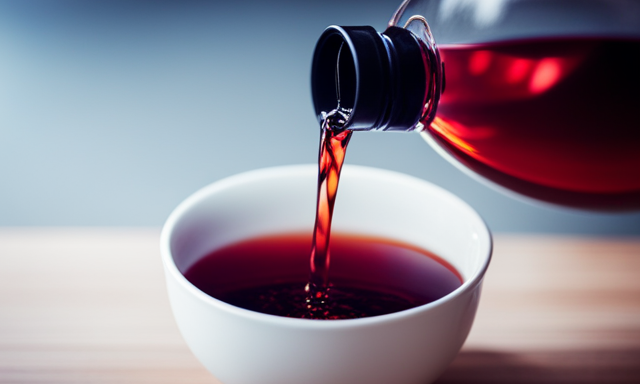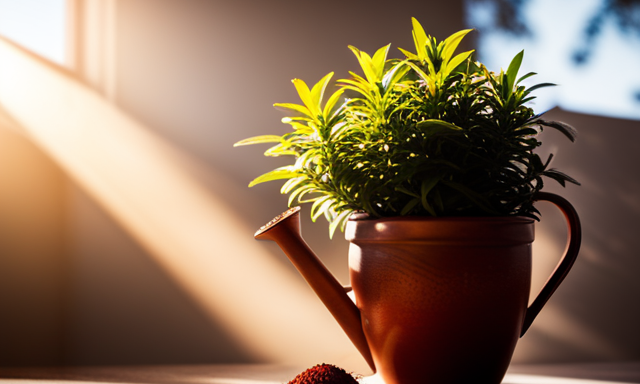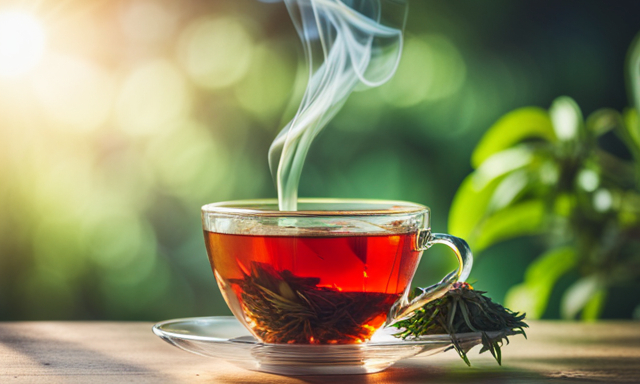I’ve discovered the secret to making the absolute best cup of rooibos tea, and let me tell you, it’s a game-changer. If you’re like me, you’ve tried your fair share of teas, searching for that perfect blend of flavor and relaxation.
Well, look no further because rooibos tea is here to save the day. With its rich, earthy taste and numerous health benefits, it’s no wonder this tea has gained popularity around the world.
In this article, I’m going to share with you my tried and true methods for selecting the finest rooibos leaves, preparing the perfect cup, and even exploring different recipes to spice things up.
So grab your favorite mug and get ready to embark on a journey of tea-sipping bliss. Trust me, once you’ve experienced the magic of rooibos tea, you’ll never go back to your old tea routine again.
Key Takeaways
- Choose vibrant and sweet-smelling rooibos leaves for the best flavor
- Ethically sourced and sustainably grown leaves are important
- Traditional steeping involves boiling water and steeping for five minutes
- Cold brewing takes at least 8 hours in the refrigerator
Understanding Rooibos Tea
If you’re looking for a caffeine-free alternative, rooibos tea is the perfect choice. Not only is it delicious, but it also offers a multitude of health benefits.
Understanding the health benefits of rooibos tea is essential in appreciating its value. Rooibos tea is rich in antioxidants, which can help boost the immune system and fight off diseases. It also contains minerals like calcium, magnesium, and potassium, which are essential for maintaining a healthy body.
Furthermore, rooibos tea comes in different varieties, such as green rooibos and red rooibos, each with its own unique flavor profile. Exploring these varieties allows you to find the one that suits your taste buds the best.
Now, let’s delve into the next section and learn how to select the finest rooibos leaves.
Selecting the Finest Rooibos Leaves
When it comes to choosing the crème de la crème of rooibos leaves, nothing surpasses the satisfaction of indulging in the finest blend. Selecting premium rooibos varieties is the key to crafting the best cup of rooibos tea.
It is important to source ethical rooibos leaves that are grown sustainably and harvested with care. Look for leaves that are vibrant in color, indicating their freshness and quality. The leaves should also have a sweet, earthy aroma, which is a sign of their flavor potential.
By carefully selecting the finest rooibos leaves, you ensure a rich and robust tea experience.
Now, let’s move on to the next step and discover how to prepare the perfect cup of rooibos tea.
Preparing the Perfect Cup of Rooibos Tea
To achieve the ultimate rooibos tea experience, it’s crucial to master the art of preparing the perfect cup. The right brewing method can enhance the flavor and aroma of this beloved South African herbal tea. One popular technique is cold brewing, which involves steeping rooibos leaves in cold water for several hours. This method brings out a smooth and mellow flavor, perfect for hot summer days. Another way to elevate your rooibos tea is through flavor pairing. Rooibos pairs well with a variety of ingredients such as citrus fruits, vanilla, honey, and ginger. These additions can enhance the natural sweetness and earthy undertones of the tea. Now, let’s delve into the various brewing methods for rooibos tea and discover the one that suits you best.
Brewing Methods for Rooibos Tea
When brewing Rooibos tea, there are several methods you can use to achieve the perfect cup. The traditional steeping method involves boiling water and steeping the tea leaves for a few minutes.
For a refreshing alternative, you can try making cold brew Rooibos tea by steeping the leaves in cold water overnight.
Lastly, if you’re in the mood for something creamy and indulgent, you can make a delicious Rooibos tea latte by combining brewed tea with steamed milk and a touch of sweetener.
Traditional Steeping
For the best cup of rooibos tea, start by steeping the leaves in boiling water for five minutes, allowing the rich flavors to infuse with each sip.
Traditional steeping is one of the most common and effective brewing methods for rooibos tea. This method not only brings out the unique taste of rooibos, but also helps to unlock its many health benefits. Rooibos tea is known for its high antioxidant content and its ability to promote relaxation and improve digestion.
By steeping the leaves in boiling water, you ensure that all these beneficial compounds are released into the tea.
Once the steeping is complete, strain the tea and enjoy it hot or pour it over ice for a refreshing cold brew version.
Cold Brew Rooibos Tea
Now that we’ve explored the traditional steeping method for making rooibos tea, let’s dive into a refreshing alternative: cold brew rooibos tea.
Cold brewing is a simple and effective way to extract the flavors of the tea without any bitterness. To make cold brew rooibos tea, start by adding loose rooibos tea leaves to a pitcher or jar. Next, fill it with cold water and let it steep in the refrigerator for at least 8 hours or overnight.
The result is a smooth and naturally sweet tea with a milder flavor profile compared to the traditional hot steeping method. Not only does cold brew rooibos tea taste great, but it also retains all the health benefits of rooibos tea, including its high antioxidant content.
Now, let’s move on to the next section where we’ll explore how to make a delicious rooibos tea latte.
Rooibos Tea Latte
Indulge in the creamy richness of a velvety Rooibos Tea Latte, where the earthy flavors of the tea blend harmoniously with the smoothness of steamed milk.
This delightful beverage can be customized to suit your taste preferences, with various rooibos tea latte variations available. For a classic latte, simply brew a strong cup of rooibos tea and froth some milk to add on top. You can also experiment with adding different spices like cinnamon or nutmeg for a spiced latte, or sweeten it with a drizzle of honey or a sprinkle of cocoa powder.
The addition of milk not only enhances the flavor and texture of the tea but also provides a boost of calcium and protein.
Now, let’s move on to the next section on serving and enjoying rooibos tea, where we’ll explore different ways to savor this delicious beverage.
Serving and Enjoying Rooibos Tea
When it comes to serving and enjoying Rooibos tea, there are a few key points to consider. Firstly, choose the right teaware to enhance the overall experience. Opt for a teapot or a teacup that allows the tea to steep properly and retain its flavors.
Secondly, consider adding sweeteners and accompaniments to enhance the taste. Honey or a splash of milk can add a touch of sweetness and creaminess to the tea.
Lastly, pair Rooibos tea with food to create a delightful combination. It pairs well with light snacks, such as scones or biscuits, as well as with savory dishes like cheese or roasted vegetables.
Choosing the Right Teaware
Selecting the appropriate teaware plays a crucial role in brewing the finest rooibos tea. When it comes to teaware options, there are a few key factors to consider. First, choose a teapot that is made of either glass or porcelain, as these materials do not affect the flavor of the tea. Avoid using metal teapots, as they may leave a metallic taste. Additionally, opt for a teapot with a built-in infuser, as this allows the tea leaves to fully expand and release their flavors. To further enhance the tea-drinking experience, use a teacup that has a wide rim, allowing the aroma to be fully appreciated. Lastly, invest in a tea cozy or tea warmer to keep the tea at the perfect temperature. With the right teaware, you can brew and savor the best rooibos tea. Now, let’s explore the next section about sweeteners and accompaniments.
Sweeteners and Accompaniments
Enhance your rooibos tea experience by adding a touch of sweetness or a dash of milk, transforming it into a warm and comforting elixir. While rooibos tea is naturally sweet and flavorful on its own, adding a sweetener can enhance its taste even further.
Some popular sweeteners to consider are honey, agave syrup, or a sprinkle of cinnamon sugar. These sweeteners not only add a touch of sweetness but also complement the earthy and nutty flavors of rooibos tea. Experimenting with different flavor combinations can take your tea experience to the next level.
For example, adding a splash of almond milk can create a creamy and nutty taste, while a squeeze of lemon can provide a refreshing twist.
Now that you’ve learned about sweeteners and flavor combinations, let’s explore how to pair rooibos tea with food.
Pairing Rooibos Tea with Food
To elevate your tea experience, consider exploring the art of pairing rooibos tea with delectable culinary creations. Rooibos tea, with its unique flavor profile, pairs excellently with a variety of foods. One delightful combination is rooibos tea and cheese. The earthy and slightly sweet notes of rooibos tea complement the creamy and savory flavors of cheese. Try pairing a rich and nutty Gouda with a cup of rooibos tea for a delightful taste experience. Another way to incorporate rooibos tea into your culinary adventures is by using it in desserts. The natural sweetness of rooibos tea adds depth and complexity to cakes, cookies, and ice creams. Experiment with infusing rooibos tea into your favorite dessert recipes to create unique and unforgettable treats. As we delve into the topic of storing and preserving rooibos tea, it’s important to understand the best practices for maintaining its freshness and flavor.
Storing and Preserving Rooibos Tea
When it comes to storing and preserving Rooibos tea, there are a few key points to keep in mind. First, it’s important to use proper storage containers that are airtight and keep out light and moisture. This will help maintain the tea’s freshness and prevent it from absorbing any unwanted flavors.
Additionally, understanding the shelf life of Rooibos tea is crucial in ensuring its quality and taste over time.
Proper Storage Containers
Using airtight containers is essential for preserving the freshness and flavor of your rooibos tea, ensuring it stays at its best for longer periods of time.
Rooibos tea is sensitive to temperature and can easily absorb odors and flavors from its surroundings. To maintain its quality, store your tea in a cool, dry place away from direct sunlight and strong odors.
Airtight containers, such as glass jars with rubber seals or metal tins with tight-fitting lids, are ideal for keeping moisture and air out. These containers help to maintain a consistent storing temperature and prevent any outside elements from affecting the flavor of your tea.
By using proper storage containers, you can enjoy a cup of perfectly brewed rooibos tea every time, without any unwanted flavor contamination.
Avoiding Flavor Contamination
In order to preserve the true essence of the delicate flavors in rooibos tea, it is crucial to keep it stored in airtight containers to prevent any unwanted taste contamination. Flavor infusion can occur when rooibos tea is exposed to strong odors or moisture, which can alter its taste and aroma. By storing it in airtight containers, you can protect the tea from these external factors and maintain its original flavors.
To further enhance your tea experience, it is important to explore different brewing techniques. Whether you prefer a stronger or milder flavor, adjusting the brewing time and water temperature can make a significant difference. The table below provides a helpful guide to brewing rooibos tea based on your desired taste profile.
| Desired Flavor | Brewing Time | Water Temperature |
|---|---|---|
| Strong | 5-7 minutes | 205°F (96°C) |
| Medium | 3-5 minutes | 195°F (90°C) |
| Mild | 1-3 minutes | 185°F (85°C) |
By understanding these brewing techniques, you can fully enjoy the rich flavors of rooibos tea. Now let’s delve into the next section about shelf life and freshness, where we will explore how to maximize the lifespan of your tea while maintaining its optimal taste.
Shelf Life and Freshness
Now that we know how to avoid flavor contamination in our rooibos tea, let’s dive into the importance of shelf life preservation and proper storing techniques. Maintaining the freshness of rooibos tea is crucial to ensure its full flavor and aroma.
To extend its shelf life, store your rooibos tea in an airtight container, away from light, moisture, and strong odors. This will prevent the tea from absorbing unwanted smells and flavors that could compromise its taste. Additionally, it’s best to keep rooibos tea in a cool, dry place, such as a pantry or cupboard. This will help preserve its natural oils and flavors.
By following these simple storing techniques, you can enjoy your rooibos tea at its best for a longer period of time.
Now, let’s explore some delightful rooibos tea recipes that will surely elevate your tea-drinking experience.
Exploring Rooibos Tea Recipes
To truly unlock the magic of rooibos tea, let your taste buds dance to the rhythm of its recipes. From refreshing rooibos tea cocktails to rejuvenating rooibos tea for skincare, there are endless ways to incorporate this delicious and versatile ingredient into your daily routine.
For a delightful twist on a classic cocktail, try mixing rooibos tea with your favorite spirits and a splash of citrus. The earthy flavors of rooibos add depth and complexity to any beverage.
And if you’re looking to pamper your skin, brew a strong cup of rooibos tea and use it as a toner or face mask. It can help hydrate and soothe your complexion.
With its numerous health benefits and unique flavor profile, rooibos tea is a true gem in the world of beverages.
Now, let’s explore the cultural significance of this remarkable tea.
Discovering the Cultural Significance of Rooibos Tea
Immerse yourself in the rich heritage and cultural significance of rooibos tea, as you delve into its origins and traditions. Rooibos tea has a long history rooted in South African cultural traditions. The indigenous Khoisan people were the first to discover the tea’s unique properties and used it for its medicinal benefits. Today, rooibos tea is not only enjoyed for its delicious taste but also for its connection to the country’s historical origins. To better understand the cultural significance, take a look at the table below:
| Cultural Traditions | Historical Origins |
|---|---|
| Rooibos ceremonies | Indigenous tribes |
| Traditional recipes | Dutch settlers |
| Healing rituals | African folklore |
| Tea rituals | British influence |
This rich tapestry of cultural traditions and historical origins sets the stage for exploring the many health and wellness benefits of rooibos tea.
Health and Wellness Tips with Rooibos Tea
Indulging in a warm cup of this soothing elixir can transport you to a state of tranquility, allowing the stress of the day to melt away. Rooibos tea, renowned for its stress-relieving properties, offers a myriad of benefits that promote health and wellness.
Packed with antioxidants, it helps to combat oxidative stress and reduce inflammation in the body. Additionally, rooibos tea contains no caffeine, making it a perfect choice for those seeking a calming beverage without the jitters.
Studies have also shown that rooibos tea can support healthy digestion and improve skin health. Its unique blend of minerals and polyphenols contributes to its ability to soothe the mind and body.
So, why not explore the world of rooibos tea alternatives and blends, to further enhance your tea-drinking experience? Transitioning into this exciting realm will open up a whole new world of flavors and aromas.
Exploring Rooibos Tea Alternatives and Blends
When it comes to exploring alternatives and blends with Rooibos tea, there are a few key points to consider. Firstly, Rooibos tea can be infused with various herbs to create unique flavors and added health benefits.
Secondly, blending Rooibos tea with fruits and spices can create a vibrant and aromatic tea experience.
Lastly, Rooibos tea can also be used as a base for creating delicious tea blends and mixes, allowing for endless possibilities and customization.
Rooibos Tea with Herbal Infusions
To enhance the flavor of your rooibos tea, you can infuse it with various herbs for a delightful twist. Adding herbal infusions not only adds depth to the taste but also introduces additional health benefits. Here are four herbal options that pair well with rooibos tea:
-
Chamomile: Known for its calming properties, chamomile adds a soothing and floral note to rooibos tea. It can help with relaxation and sleep.
-
Peppermint: If you enjoy a refreshing and minty flavor, try adding peppermint to your rooibos tea. It aids digestion and provides a cooling sensation.
-
Lavender: With its floral and slightly sweet taste, lavender complements the earthiness of rooibos tea. It promotes relaxation and can help alleviate headaches.
-
Lemon balm: For a citrusy and refreshing twist, infuse your rooibos tea with lemon balm. It’s known to improve mood and reduce anxiety.
Now, let’s explore how to blend rooibos tea with fruits and spices for a flavorful combination.
Rooibos Tea Blends with Fruits and Spices
Blending rooibos tea with fruits and spices creates a flavorful combination that will elevate your tea-drinking experience. The natural sweetness of the fruits and the aromatic spices perfectly complement the earthy and nutty flavors of rooibos tea.
One delightful way to enjoy this blend is by making rooibos tea smoothies. Simply brew a strong cup of rooibos tea and let it cool. Then, blend it with your favorite fruits like berries, mango, or pineapple for a refreshing and healthy treat.
Another option is to create rooibos tea cocktails by mixing the tea with some fruit juice and a splash of alcohol like rum or vodka. The possibilities are endless when it comes to creating delicious and unique rooibos tea blends.
Now, let’s explore how to use rooibos tea for tea blends and mixes…
Rooibos Tea for Tea Blends and Mixes
By infusing rooibos tea with a medley of aromatic herbs and delicate floral notes, you can create a tea blend that transports you to a serene garden in full bloom. The versatility of rooibos makes it an excellent base for tea blends and mixes.
Here are three tea pairings that complement the earthy, nutty flavor of rooibos while enhancing its health benefits:
1) Rooibos and Chamomile: The soothing properties of chamomile perfectly complement the calming effects of rooibos, creating a blend that promotes relaxation and aids in sleep.
2) Rooibos and Peppermint: The refreshing minty taste of peppermint adds a cooling sensation to the warm rooibos, making it a perfect choice for a revitalizing morning blend.
3) Rooibos and Hibiscus: The tartness of hibiscus balances the sweetness of rooibos, creating a vibrant blend that is rich in antioxidants and promotes heart health.
By experimenting with different tea pairings, you can create unique flavors while enjoying the numerous health benefits of rooibos tea.
Frequently Asked Questions
Can I use rooibos tea bags instead of loose leaves?
Yes, you can use rooibos tea bags instead of loose leaves. However, using loose leaf rooibos tea has its benefits, such as richer flavor and higher quality. Rooibos tea bags come in different flavors for variety.
How long does rooibos tea stay fresh?
Rooibos tea stays fresh for up to two years if stored properly. To maximize shelf life, keep it in an airtight container away from light and moisture. Enjoy the full flavor and benefits of rooibos tea!
Can I add milk or sugar to my rooibos tea?
Yes, you can add milk or sugar to your rooibos tea. Adding milk gives it a creamy taste, while adding sugar sweetens it. Experiment with different amounts to find your preferred taste.
Is rooibos tea safe for pregnant women?
Rooibos tea is safe for pregnant women to consume. It offers numerous benefits, such as being caffeine-free and rich in antioxidants. Additionally, it can be enjoyed while breastfeeding as it does not contain any harmful substances.
Can I drink rooibos tea before bedtime?
Yes, drinking rooibos tea before bedtime is a great choice. It provides numerous benefits like aiding in digestion and promoting relaxation. If you prefer alternatives, herbal teas like chamomile or lavender are also good options.
Conclusion
In conclusion, Rooibos tea is a delightful and versatile beverage that can be enjoyed in various ways. From selecting the finest leaves to preparing the perfect cup, there are endless possibilities to explore.
For example, Sarah, a busy professional, discovered the calming effects of Rooibos tea after trying it as a natural remedy for stress. She now incorporates it into her daily routine, finding comfort and relaxation in every sip.
With its cultural significance, health benefits, and potential for creative recipes, Rooibos tea is truly a treasure worth discovering. So go ahead, indulge in a cup of Rooibos tea and experience its wonders for yourself.










